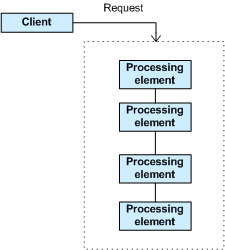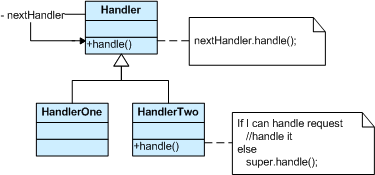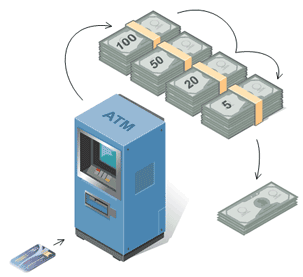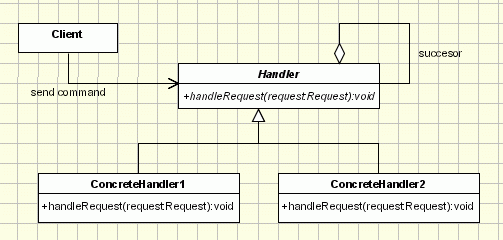Definition
Let more than one object handle a request without their knowing each other. Pass the request to chained objects until it has been handled.Where to use & benefits
- One request should be handled by more than one object.
- Don't know which object should handle a request, probably more than one object will handle it automatically.
- Reduce coupling.
- Flexible in handling a request.
- Related patterns include
- Composite, which a chain of responsibility pattern is often applied in conjunction with.
Intent
01- Avoid coupling the sender of a request to its receiver by giving more than one object a chance to handle the request. Chain the receiving objects and pass the request along the chain until an object handles it.
- Launch-and-leave requests with a single processing pipeline that contains many possible handlers.
- An object-oriented linked list with recursive traversal.
Problem
02There is a potentially variable number of “handler” or “processing element” or “node” objects, and a stream of requests that must be handled. Need to efficiently process the requests without hard-wiring handler relationships and precedence, or request-to-handler mappings.

Discussion
03Encapsulate the processing elements inside a “pipeline” abstraction; and have clients “launch and leave” their requests at the entrance to the pipeline.

The pattern chains the receiving objects together, and then passes any request messages from object to object until it reaches an object capable of handling the message. The number and type of handler objects isn’t known a priori, they can be configured dynamically. The chaining mechanism uses recursive composition to allow an unlimited number of handlers to be linked.
05Chain of Responsibility simplifies object interconnections. Instead of senders and receivers maintaining references to all candidate receivers, each sender keeps a single reference to the head of the chain, and each receiver keeps a single reference to its immediate successor in the chain.
06Make sure there exists a “safety net” to “catch” any requests which go unhandled.
07Do not use Chain of Responsibility when each request is only handled by one handler, or, when the client object knows which service object should handle the request.
Structure
08The derived classes know how to satisfy Client requests. If the “current” object is not available or sufficient, then it delegates to the base class, which delegates to the “next” object, and the circle of life continues.

Multiple handlers could contribute to the handling of each request. The request can be passed down the entire length of the chain, with the last link being careful not to delegate to a “null next”.
Example
10The Chain of Responsibility pattern avoids coupling the sender of a request to the receiver by giving more than one object a chance to handle the request. ATM use the Chain of Responsibility in money giving mechanism.

Check list
11- The base class maintains a “next” pointer.
- Each derived class implements its contribution for handling the request.
- If the request needs to be “passed on”, then the derived class “calls back” to the base class, which delegates to the “next” pointer.
- The client (or some third party) creates and links the chain (which may include a link from the last node to the root node).
- The client “launches and leaves” each request with the root of the chain.
- Recursive delegation produces the illusion of magic.
Rules of thumb
12- Chain of Responsibility, Command, Mediator, and Observer, address how you can decouple senders and receivers, but with different trade-offs. Chain of Responsibility passes a sender request along a chain of potential receivers.
- Chain of Responsibility can use Command to represent requests as objects.
- Chain of Responsibility is often applied in conjunction with Composite. There, a component’s parent can act as its successor.
Motivation
In writing an application of any kind, it often happens that the event generated by one object needs to be handled by another one. And, to make our work even harder, we also happen to be denied access to the object which needs to handle the event. In this case there are two possibilities: there is the beginner/lazy approach of making everything public, creating reference to every object and continuing from there and then there is the expert approach of using the Chain of Responsibility.
The Chain of Responsibility design pattern allows an object to send a command without knowing what object will receive and handle it. The request is sent from one object to another making them parts of a chain and each object in this chain can handle the command, pass it on or do both. The most usual example of a machine using the Chain of Responsibility is the vending machine coin slot: rather than having a slot for each type of coin, the machine has only one slot for all of them. The dropped coin is routed to the appropriate storage place that is determined by the receiver of the command.
Intent:
- It avoids attaching the sender of a request to its receiver, giving this way other objects the possibility of handling the request too.
- The objects become parts of a chain and the request is sent from one object to another across the chain until one of the objects will handle it.
Implementation
The UML diagram of classes below will help us understand better the way the Chain works.

Example
The Java Servlet filter framework is an example of chain of resposibility design. Note that the chain.doFilter() is the method that should be called to make the chain roll. If the subclass missed it, the whole chain would be stopped or blocked.Java exception handling is another example of chain of responsibility design. When an error occurs, the exception call will look for a handling class. If there is no handler, the super Exception class will be called to throw the exception. Otherwise, the handler class will handle it.
Here comes a simple example, just to show how chain of responsibility works. Whenever you spend company's money, you need get approval from your boss, or your boss's boss. Let's say, the leadership chain is:
Manager-->Director-->Vice President-->PresidentThe following is a command line program to check who is responsible to approve your expenditure.
import java.io.*;
abstract class PurchasePower {
protected final double base = 500;
protected PurchasePower successor;
public void setSuccessor(PurchasePower successor){
this.successor = successor;
}
abstract public void processRequest(PurchaseRequest request);
}
class ManagerPPower extends PurchasePower {
private final double ALLOWABLE = 10 * base;
public void processRequest(PurchaseRequest request ) {
if( request.getAmount() < ALLOWABLE )
System.out.println("Manager will approve $"+ request.getAmount());
else
if( successor != null)
successor.processRequest(request);
}
}
class DirectorPPower extends PurchasePower {
private final double ALLOWABLE = 20 * base;
public void processRequest(PurchaseRequest request ) {
if( request.getAmount() < ALLOWABLE )
System.out.println("Director will approve $"+ request.getAmount());
else
if( successor != null)
successor.processRequest(request);
}
}
class VicePresidentPPower extends PurchasePower {
private final double ALLOWABLE = 40 * base;
public void processRequest(PurchaseRequest request) {
if( request.getAmount() < ALLOWABLE )
System.out.println("Vice President will approve $" + request.getAmount());
else
if( successor != null )
successor.processRequest(request);
}
}
class PresidentPPower extends PurchasePower {
private final double ALLOWABLE = 60 * base;
public void processRequest(PurchaseRequest request){
if( request.getAmount() < ALLOWABLE )
System.out.println("President will approve $" + request.getAmount());
else
System.out.println( "Your request for $" + request.getAmount() + " needs a board meeting!");
}
}
class PurchaseRequest {
private int number;
private double amount;
private String purpose;
public PurchaseRequest(int number, double amount, String purpose){
this.number = number;
this.amount = amount;
this.purpose = purpose;
}
public double getAmount() {
return amount;
}
public void setAmount(double amt){
amount = amt;
}
public String getPurpose() {
return purpose;
}
public void setPurpose(String reason) {
purpose = reason;
}
public int getNumber(){
return number;
}
public void setNumber(int num) {
number = num;
}
}
class CheckAuthority {
public static void main(String[] args){
ManagerPPower manager = new ManagerPPower();
DirectorPPower director = new DirectorPPower();
VicePresidentPPower vp = new VicePresidentPPower();
PresidentPPower president = new PresidentPPower();
manager.setSuccessor(director);
director.setSuccessor(vp);
vp.setSuccessor(president);
//enter ctrl+c to kill.
try{
while (true) {
System.out.println("Enter the amount to check who should approve your expenditure.");
System.out.print(">");
double d = Double.parseDouble(new BufferedReader(new InputStreamReader(System.in)).readLine());
manager.processRequest(new PurchaseRequest(0, d, "General"));
}
}catch(Exception e){
System.exit(1);
}
}
} C:\ Command Prompt
C:\> javac CheckAuthority.java
C:\> java CheckAuthority
Enter the amount to check who should approve your expenditure.
>500
Manager will approve $500.0
Enter the amount to check who should approve your expenditure.
>5000
Director will approve $5000.0
Enter the amount to check who should approve your expenditure.
>11000
Vice President will approve $11000.0
Enter the amount to check who should approve your expenditure.
>30000
Your request for $30000.0 needs a board meeting!
Enter the amount to check who should approve your expenditure.
>20000
President will approve $20000.0
Enter the amount to check who should approve your expenditure.
>
C:\> |
The composite pattern is often used with chain of responsibility. That means a class may contain the related class that may handle the request.
Example : 2
Chain of Responsibility in Java: Before and after
Why read if you can watch?
Watch design patterns video tutorialBefore
01
The client is responsible for stepping
through the “list” of
02
Handler objects, and determining when
the request has been handled.
class Handler
{
private static java.util.Random s_rn = new java.util.Random();
private static int s_next = 1;
private int m_id = s_next++;
public boolean handle(int num)
{
if (s_rn.nextInt(4) != 0)
{
System.out.print(m_id + "-busy ");
return false;
}
System.out.println(m_id + "-handled-" + num);
return true;
}
}
public class ChainDemo
{
public static void main(String[] args)
{
Handler[] nodes =
{
new Handler(), new Handler(), new Handler(), new Handler()
};
for (int i = 1, j; i < 10; i++)
{
j = 0;
while (!nodes[j].handle(i))
j = (j + 1) % nodes.length;
}
}
}1-busy 2-busy 3-busy 4-busy 1-busy 2-handled-1
1-busy 2-busy 3-handled-2
1-busy 2-busy 3-busy 4-handled-3
1-busy 2-busy 3-busy 4-busy 1-busy 2-busy
3-handled-4
1-busy 2-busy 3-handled-5
1-handled-6
1-busy 2-handled-7
1-busy 2-busy 3-busy 4-busy 1-busy 2-busy
3-busy 4-handled-8
1-busy 2-handled-9
After
03
The client submits each request to the
“chain” abstraction and is decoupled from all subsequent processing.
04
class Handler
{
private static java.util.Random s_rn = new java.util.Random();
private static int s_next = 1;
private int m_id = s_next++;
private Handler m_next;
public void add(Handler next)
{
if (m_next == null)
m_next = next;
else
m_next.add(next);
}
public void wrap_around(Handler root)
{
if (m_next == null)
m_next = root;
else
m_next.wrap_around(root);
}
public void handle(int num)
{
if (s_rn.nextInt(4) != 0)
{
System.out.print(m_id + "-busy ");
m_next.handle(num);
}
else
System.out.println(m_id + "-handled-" + num);
}
}
public class ChainDemo
{
public static void main(String[] args)
{
Handler chain_root = new Handler();
chain_root.add(new Handler());
chain_root.add(new Handler());
chain_root.add(new Handler());
chain_root.wrap_around(chain);
for (int i = 1; i < 10; i++)
chain_root.handle(i);
}
}1-busy 2-busy 3-handled-1
1-busy 2-busy 3-busy 4-busy 1-handled-2
1-busy 2-busy 3-busy 4-busy 1-busy 2-busy
3-busy 4-busy 1-handled-3
1-busy 2-handled-4
1-busy 2-busy 3-busy 4-handled-5
1-busy 2-busy 3-busy 4-busy 1-busy 2-handled-6
1-busy 2-handled-7
1-handled-8
1-busy 2-busy 3-handled-9
No comments:
Post a Comment